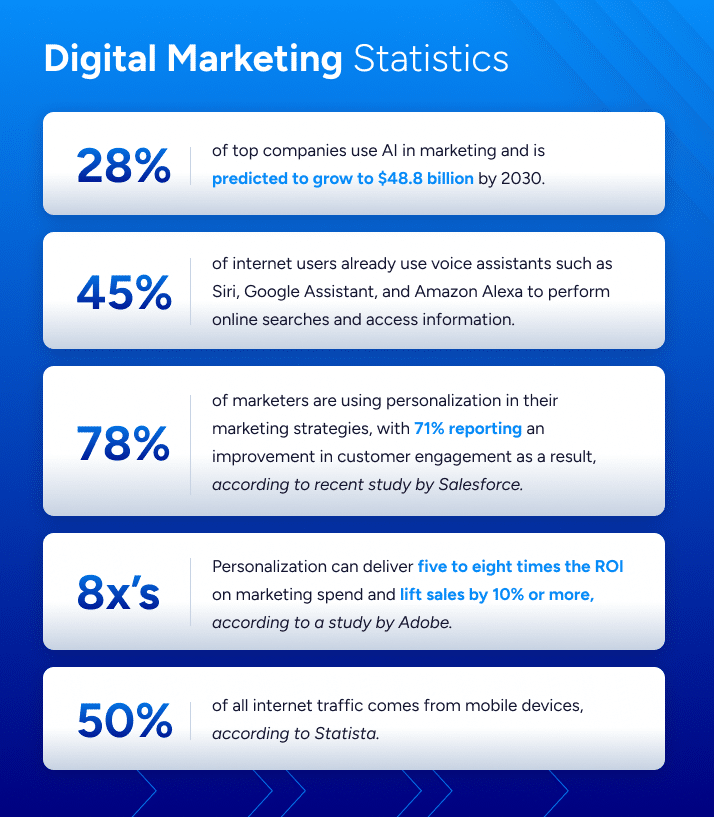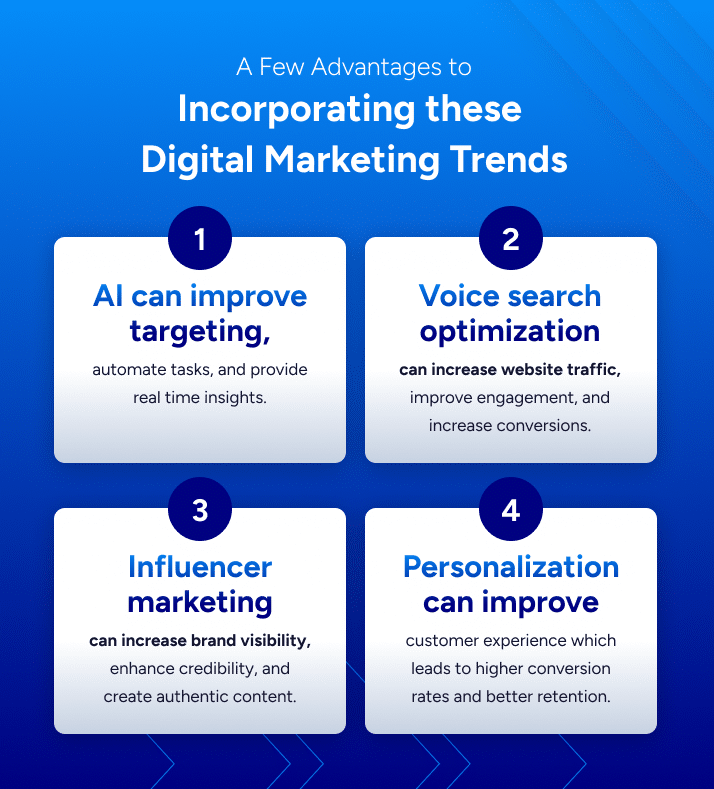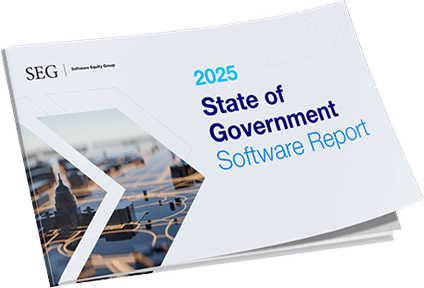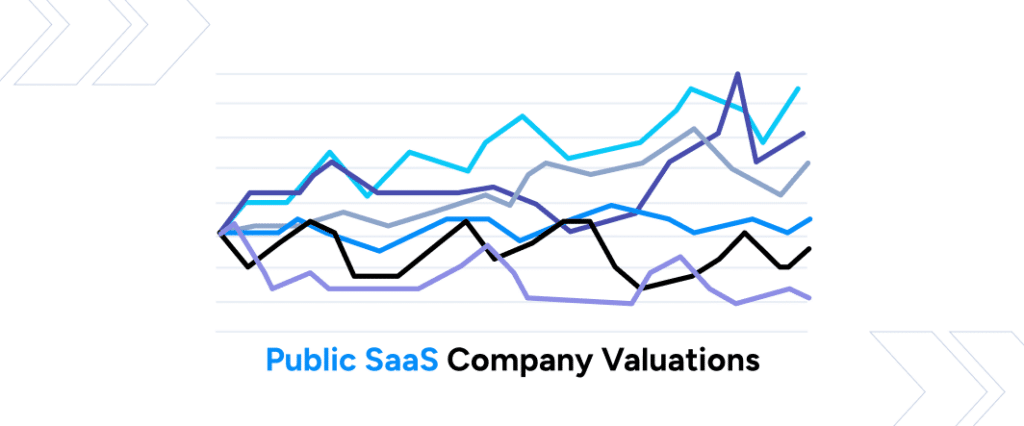4 Emerging Digital Marketing Trends + How SaaS Companies Can Use Them

Recently, I was talking with a SaaS CEO who is contemplating an exit. His business is growing at 35% EBITDA and has 95% gross retention: strong metrics which could contribute to him attaining his exit multiple goals.
But not everything was rosy. He discussed a few of his struggles, which were mainly around Sales & Marketing. This isn’t uncommon, by the way. Most CEOs understand that marketing is important, but they usually don’t have a background in it and don’t know where to start. [Here you can read about the marketing initiatives I used to grow a previous SaaS company]
In response to this CEO’s concerns, I shared the significant benefits that SaaS companies can achieve by incorporating digital marketing (the use of digital channels such as search engines, social media, email, and websites to promote products, services, or brands). This CEO then asked me what digital marketing trends were emerging specifically for SaaS companies.
Ultimately, his question inspired this post, which looks at 4 emerging digital marketing trends, along with examples of how SaaS companies can use them to further their marketing efforts.
Digital Marketing Trends for SaaS Companies
Before we talk about emerging trends, let’s discuss mobile-first, a fundamental requirement, and standard practice in today’s digital landscape.
As more and more customers access digital services over smartphones, tablets, and wearable devices, businesses need to ensure a mobile-friendly experience in order to reach and engage their target audience effectively. A mobile-first approach is a design and development strategy that prioritizes user experience on mobile devices over other platforms like desktop computers. It involves designing and optimizing websites, applications, and digital content specifically for mobile devices, with the aim of delivering a seamless and user-friendly experience to mobile users.
A mobile-first approach has a number of implications for your business, including improved SEO, access to valuable customer data, and the ability to better personalize the user’s experience with your brand (see Personalization, below).
The marketing landscape is constantly evolving. SaaS leaders who want to stay ahead of the curve should keep an eye on the horizon and be prepared to experiment with new trends and technologies. We have identified four digital marketing trends that small to midsized SaaS companies in particular should be aware of, along with some examples of how businesses can incorporate them into their marketing strategies.
Digital Marketing Insights
Here are some recent digital marketing statistics that provide insights into the current state of the industry:

Trend #1: Artificial Intelligence (AI)
If you’ve chatted with a chatbot, steered clear of bad traffic with the help of your GPS, or gotten a fraud alert from your bank, you’ve seen artificial intelligence (AI) in action. AI is already being used in marketing by 28% of top companies use AI in marketing and the market is predicted to grow to $48.8 billion by 2030.
AIs are machine learning algorithms and other advanced technologies designed to combine information, analyze material, make decisions, and “learn” based on feedback. This enables them to analyze large sets of data, identify patterns and trends, and automate tasks that would be time-consuming or difficult to do manually.
As an emerging digital marketing trend, AI offers several advantages over traditional marketing methods, including improved targeting and personalization, automation of repetitive tasks, and real-time insights. AI can be used to predict customers’ needs, analyze their behavior, and personalize their experience with a brand, transforming the way marketers analyze and leverage data to improve customer engagement and drive conversions.
How SaaS Companies Can Use AI
A SaaS company offering project management software could, for example, use machine learning algorithms to analyze large sets of data and identify patterns and trends in user behavior, such as which keywords or ad placements are most effective in driving conversions. Based on this analysis, the company could then adjust its PPC ad campaigns in real-time to optimize bidding strategies, ad copy, and targeting criteria. By continually analyzing the performance of its ads and adjusting its tactics accordingly, the SaaS company can improve the efficiency and effectiveness of its ad campaigns, ultimately leading to increased conversions and revenue growth.
Of course, one of the most common uses of AI is content production, which has exploded across the business world since ChatGPT was released in November of 2022. While efficient, AI should be used judiciously; the content is often formulaic, with poor SEO; ChatGPT even warns that it may produce inaccurate information. With appropriate safeguards in place, though, companies can serve up quality content while streamlining their production by using AI to generate ideas, create outlines, streamline research, summarize existing articles, and more.
Trend #2: Voice Search Optimization
In part due to the rise of AI content, voice search optimization is becoming increasingly crucial. Almost 45% of internet users already use voice assistants such as Siri, Google Assistant, and Amazon Alexa to perform online searches and access information. Fast, intuitive, and hands-free, voice search is becoming increasingly popular and more reliable. As voice technology continues to advance, optimizing content for voice search will become more important.
How SaaS Companies Can Leverage Voice Search
Leaders interested in incorporating voice search optimization should focus on creating content that answers specific questions and optimizing it for long-tail keywords. For instance, a SaaS company offering customer relationship management (CRM) software could optimize its website and content to include long-tail keywords and natural language queries that are more likely to be used in voice searches. They could also include featured snippets or answer boxes on their website that provide quick answers to common questions related to their product or industry.
Additionally, the SaaS company could create content specifically for voice assistants such as Amazon Alexa or Google Assistant by providing detailed answers to common customer questions and using conversational language. This content could be distributed through various voice-enabled devices, such as smart speakers and mobile devices.
With tactics like these, the SaaS company can improve its visibility and reach a wider audience, particularly among users who prefer to use voice search on their devices. This can help to increase website traffic, improve engagement, and ultimately lead to increased conversions and revenue growth.

Trend #3: Influencer Marketing
Another way to reach a wider audience is by incorporating influencer marketing into your marketing strategy. Influencer marketing means collaborating with influential individuals to increase your reach, build trust, and educate your audience about your products. At SEG, for example, we reach out to well-known investor brands like Vista Equity Partners, Mainsail Partners, and Level Equity and put together panels to discuss their perspectives on the market. We also collaborate with industry experts, like Paul Lachance, to publish research on specific industries where we have a focus.
How SaaS Companies Can Capitalize on Influencer Marketing
Successful influencer marketing rests on the fact that people are likely to listen to their peers, people they can relate to and respect. Look for partners with professional credibility who can address the pain points of your target audience. Guest blogging, webinars, client stories, and podcast interviews are some of the channels an influencer can use to engage your audience. Depending on your audience, there may be opportunities for real-life collaboration as well, such as panel events at conferences.
Trend #4: Personalization
Personalization is the use of data and technology to deliver customized content, messaging, and offers to individuals based on their preferences, behavior, and past interactions with the business. Think of Netflix’s recommendations based on your viewing habits or the way Amazon’s home page is tailored to your interests. Personalization can help improve customer loyalty, retention, and customer advocacy by creating a more engaging, relevant experience. Moreover, it can help businesses improve their targeting and segmentation strategies by providing insights into customer behavior and preferences.
Personalized marketing has existed for a while, but with advancements in AI and data analytics, brands are increasingly able to provide these experiences at scale. B2B companies can now personalize reviews based on a website user’s business size, for example, or customize website images to the user’s industry. However you use it, don’t overlook the power of personalization: 77% of B2B buyers will not make a purchase without content that speaks to their individual needs and interests.
How SaaS Companies Can Apply Personalization
To put personalization in context, imagine a Real Estate software company that offers a property rental or purchase platform. The company could collect information on customer location, budget, property preferences, and other relevant factors, and use that data to make personalized recommendations that match specific customer needs and interests. These could include personalized email campaigns with specific messages and offers, or personalized landing pages that highlight listings in a specific area and provide relevant information on the neighborhood, schools, and amenities.
By engaging customers with a personalized and relevant experience, the company can increase loyalty and conversion rates while also collecting valuable data that can inform future marketing efforts and lead to improved performance overall.
Evaluate Digital Marketing Strategy First
Understanding these digital marketing trends is important, but before you jump on one or more, take the time to evaluate your current marketing strategy. Do a thorough marketing audit and make sure you’ve clearly defined your ideal customer profile, marketing objectives, and goals. Once you’ve done that, it’s time to assess the resources and budget required to implement and sustain a new direction.
And if you’re struggling, don’t despair. Marketing isn’t easy, and for young B2B SaaS companies still learning how to differentiate their product and define their audience, it can be particularly difficult and frustrating. Our goal at SEG is to educate SaaS operators, buyers, and financial backers on the market, metrics, insights, and trends happening within SaaS M&A—and that includes marketing. Click here if you’d like to speak to one of our M&A experts to learn how implementing strategies like the ones above can improve your company valuation.









